|
|
|
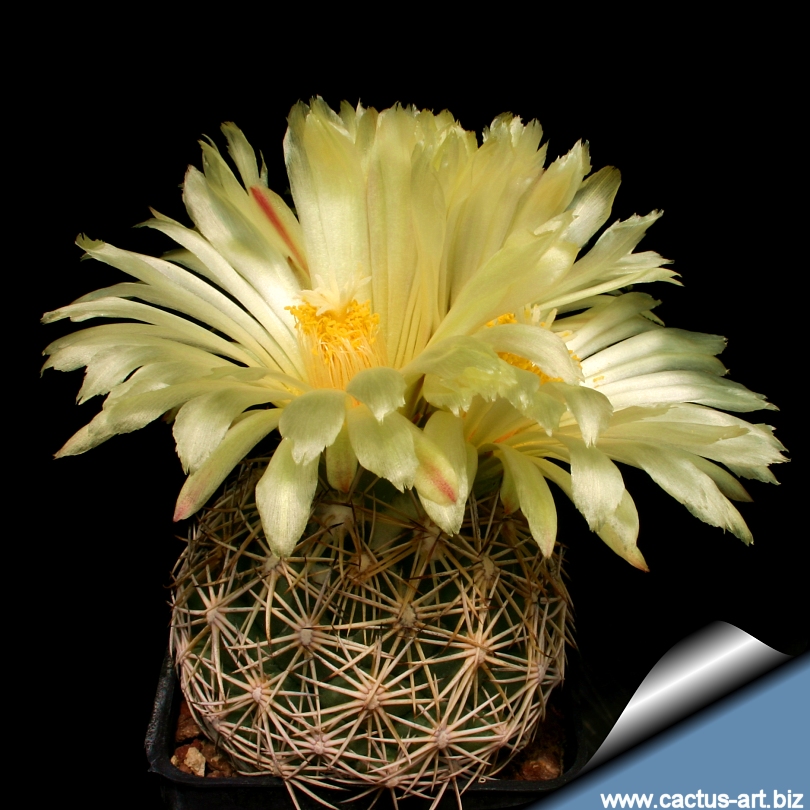
Coryphantha
cornifera SB44
Ixmilquilpan Hidalgo (Mexico)
This species is one of those Coryphanthas which pass a purely
radial-spined youth stage in which they are already floriferous.
Most of
the plants develop the central spines only at the age of 7
to 15 years.
|
|
 |
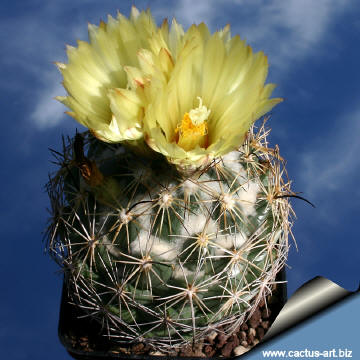
|
|
|
|
|
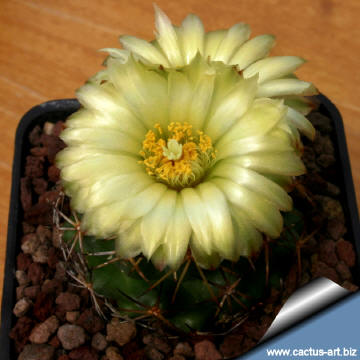 |
 |
|
Mature Coryphantha cornifera are dimorphic with respect to
presence/absence of porrect central spines. |
|
 |
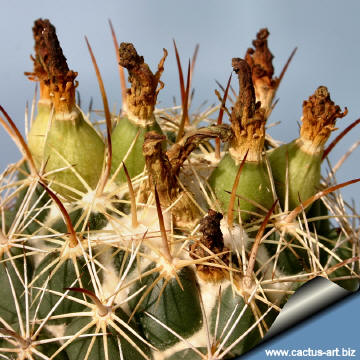
|
|
|
|
|
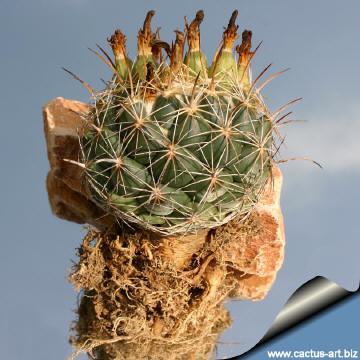 |

|
|
Cultivation: In culture C. cornifera is without problems, and
regularly shows its large yellow flowers. It does best in slight shade,
but does well in full sun too. It is sensitive to overwatering (rot
prone), and needs a very porous soil with good drainage. It flowers
quite early, but needs about 8-12 years to reach the typical, definite
outlook. It tolerates fairly low temperatures as long as it is kept dry
(hardy to -5° C or less for short periods of time).
Propagation: Propagation is by seed.
Photo of conspecific taxa,
varieties and cultivars of plants belonging to
the cornifera /radians
complex
(This
Taxon
has lots of synonyms, with
several controversial varieties and subspecies):
|
|


Advertising
|
|
|
|
|
Family:
Cactaceae (Cactus
Family)
Scientific name:
Coryphantha
cornifera (De Candolle) Lemaire
Cactéè, 35, 1868
Basionym: Mammillaria cornifera De Candolle
Mém. Mus. Hist. Nat. Paris, 17, 112 1828
Origin: The main
distribution is in the Mexican states of Querétaro and Hidalgo,
south to the Valle de Mexico, north to Guanajuato and
sporadically in San Luis Potosí.
Habitat:
Limestone gravel on low hills and plain.
Conservation status: Listed in
CITES appendix 2.
Common Names include: Sea-urchin cactus,
rhinoceros cactus, Prickly Beehive Cactus
Coryphantha cornifera /radians
complex:
Coryphantha cornifera is thought to be the taxon
classified in 1828 by de Candolle as Mammillaria radians,
but this is unclear, partly because of various name changes over the
years.
However the range of both Coryphantha radians and
Coryphantha cornifera is identical, and at most locations adult
plants, either without central spines ("radians"), or with
1-4 central spines ("cornifera") can be found. The
arrangement of the central spines is variable.
With the exception of the
absence or existence of centrals, all the other characteristics are
absolutely identical, namely size and form of tubercles, number, size
and arrangement of radial spines, flowers, fruits and seeds. Furthermore
this species is one of those Coryphanthas which pass a purely
radial-spined long youth stage in which they are already floriferous.
Most of the plants after several years develop the central
spines, giving the plant its sea urchin appearance.
Synonyms:
- Coryphantha radians (De Candolle)
Britton & Rose
Cactaceae, 4 : 36, 1923
- Mammillaria radians De Candolle
In :Mém. Mus. Hist. Nat. Paris, 17, 111 1828
- Aulacothele radians (De candolle
) Monville
Cat. Pl. Exot., 21, 1846
- Aulacothele cornifera (De
candolle) Molville
Cat. Pl. Exot., 21, 1846
- Mammillaria pfeifferiana De
Vriese
Tydschr. Nat. Geschr. 6: 51, 1839.
- Echinocactus radians (De Candolle)
Poselger
Allg. Gartenz. 21 : 107, 1853
- Echinocactus corniferus (De
Candolle) Posselger
Allg. Gartenz. 21 : 102, 1853
- Cactus radians (De candolle)
Kuntze
Rev. Gen. Pl. 1 :261, 1891
- Mammillaria cornifera (De
Candolle) Lemaire
In : Cactée 35, 1868
- Coryphantha cornuta
- Coryphantha schwartziana
- Coryphantha maliterrarum
- Coryphantha bernalensis
|
|
Description:
This is a very variable species, normally solitary, rarely sprouting.
Stem: Flat globose to cylindrical, up to 8-15 cm in diameter,
6-12 cm tall, dull olive-green, apex depressed, with a blunt, depressed
apex covered with e wool.
Tubercles: Tubercles are spirally arranged in
series of
5 and 8.
Conical, rhomboid at the base, obliquely cut, grooved above; on new
growth the groove may show some felt. Basal diameter 12-16 mm, 8-14 mm
tall. Axil at first woolly, then naked.
Areoles: Oval, 3mm long, 2,5 mm wide (when central spines absent),
round 2 mm Ø (when central spine present)
Radial spines: 10 to 20 fairly stout, pale whitish, yellow or
horn-coluoured, sometimes darker tipped, 0.9-1.6 cm long, horizontal,
irregularly radiating, interwoven, needle-like, straight or slightly
curved; in youth pectinate. Occasionally 3-4 thinner spines, more
densely set.
Central spines:
0 or 1( to 3), dark brown, becoming grey from the base, subulate. The
dominant central is straight,
porrect, or curved downward, usually about
1 cm long, but it may be longer on older plants (up to 1,8 cm); the
other two protruding laterally, and curved.
Roots: Fibrous root or semi-taproot.
Flowers: Very big, 5-7 cm wide, yellow (occasionally red), funnel
shaped, 6-7 cm. The linear segments are lemon-yellow, sometimes red at
the base. Filaments reddish to reddish-yellow. Anthers yellow, stigma
pale yellow, stigma lobes whitish.
Fruit: Green, juicy with attached flower remnants, 20-25 mm
long, 10 mm wide.
Seed: Reniform
(kidney-shaped), brown, 1,3 mm long.
|
|
|
|

Coryphantha radians REP37 Locality: Colon,
Querétaro, Mexico 2000m

|
|